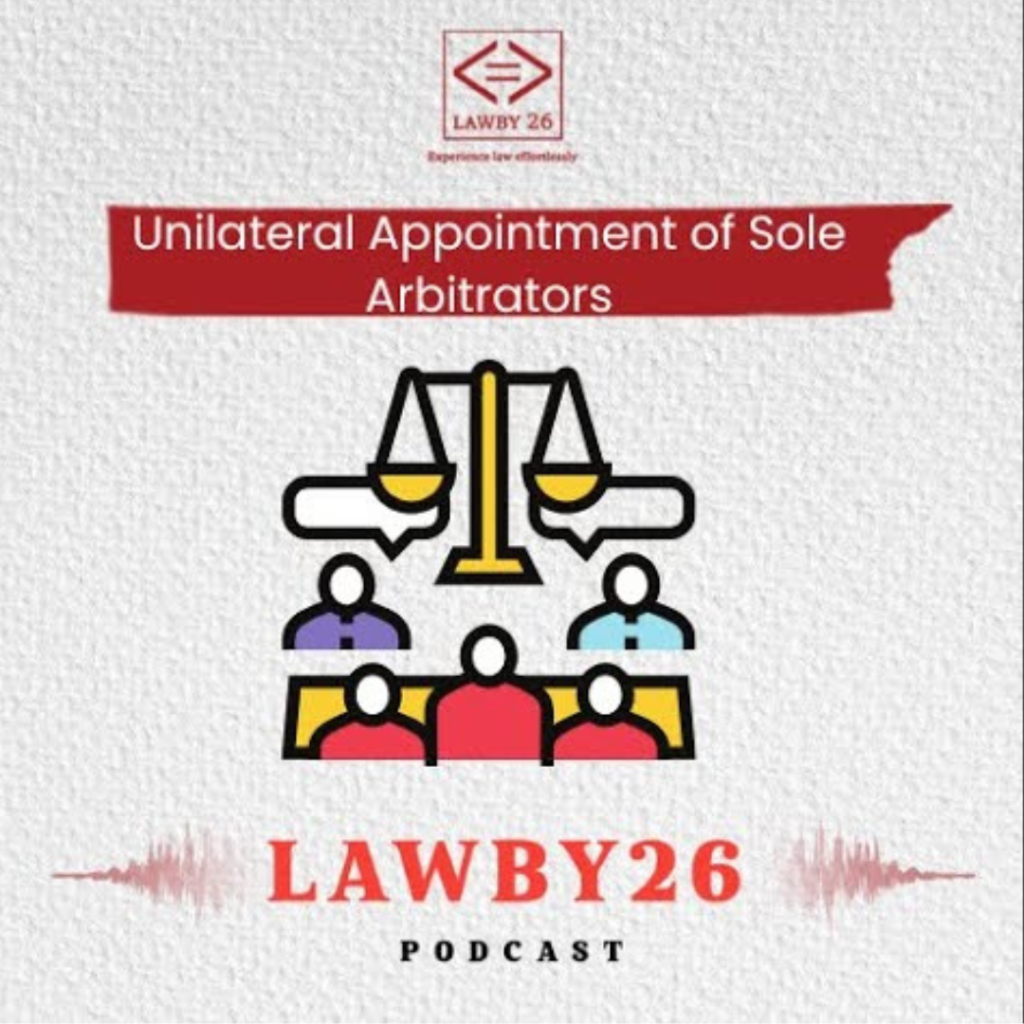Rights of an Unmarried Daughter In India

https://www.youtube.com/watch?v=4inhaC3B6mw Unveiling Legal Equality: Empowering Unmarried Daughters with Rights In this episode of the LAWBY 26 Podcast, we discuss the legal rights of unmarried daughters. Covering inheritance, property, and financial autonomy, we highlight the modern legal framework aiming for gender equality. Tune in as we explore the rights shaping the lives of unmarried daughters. Done By: Seethala Baskar, Lawyer This content was uploaded on 05/03/2025
Unilateral appointment of sole arbitrators

https://www.youtube.com/watch?v=Q5cRi8ebUsk Arbitration Unveiled: The Dynamics of Unilateral Appointment of Sole Arbitrators. In this episode of the LAWBY 26 Podcast, we explore the nuanced topic of the unilateral appointment of sole arbitrators. Delving into the legal intricacies, we examine the process by which a single party can appoint an arbitrator in dispute resolution. Join us as we unravel the implications, challenges, and significance of this practice in the realm of arbitration. Done By: G Angujanani, Lawyer This content was uploaded on 05/03/2025
Rights of the LGBTQIA+ community

https://www.youtube.com/watch?v=lizCpFti0Gc Navigating Legal Equality: Unraveling the Rights of the LGBTQ Community In this episode of LAWBY 26 Podcast, we illuminate the legal rights of the LGBTQ community. From anti-discrimination measures to recognition of same-sex relationships, we explore the evolving legal landscape that aims to ensure equal rights and protections. Join us as we delve into the rights shaping the lives of the LGBTQ community in pursuit of inclusivity and justice. Done By: Sowmiya R K, Lawyer This content was uploaded on 05/03/2025
Right to safe food

https://www.youtube.com/watch?v=iQ37aGeaUP8 Safeguarding Plates & Ensuring Rights: Unpacking the Right to Safe Food In this episode of LAWBY 26 podcast, we delve into the fundamental right to safe food. Exploring the legal dimensions, we uncover how this right is enshrined to protect consumers, ensuring food safety standards and regulations. Join us as we navigate the legal landscape that safeguards the public’s right to access and consume safe, quality food. Done By: Sruthi, Lawyer This content was uploaded on 05/03/2025
9th Schedule of the Indian Constitution

https://www.youtube.com/watch?v=ZzR3UDEcH6k Behind the Legal Veil: Decoding the 9th Schedule of the Indian Constitution. In this episode of LAWBY 26 Podcast, we unravel the significance of the 9th Schedule of the Indian Constitution. A legal shield that protects specific laws from judicial review, fostering a delicate balance between constitutional rights and social welfare. Join us as we explore the intricacies of this constitutional tool and its impact on India’s legal landscape. Done By: Seethala Baskar, Lawyer This content was uploaded on 05/03/2025
Nuances of Digital Data Protection Act, 2023

https://www.youtube.com/watch?v=JUoVXk_Bd44 Guardians of the Digital Realm: Decoding the Digital Data Protection Act, 2023 In this episode of LAWBY 26 Podcast, we dissect the intricacies of the Digital Data Protection Act, 2023. Navigating the evolving landscape of digital privacy, we unravel the key provisions, rights, and responsibilities outlined in this legislative framework. Join us as we explore the implications for individuals, businesses, and the broader digital ecosystem in an era where safeguarding datais paramount. Done By: G Angujanani, Lawyer This content was uploaded on 05/03/2025
Replacement of colonial justice laws in India

https://www.youtube.com/watch?v=HkerPBA88Zw In the series of LAWBY TRENDZ, embark on a legal exploration which delves into the transformation and replacement of colonial-era justice laws in India. This analysis sheds light on the evolution of the legal framework, offering valuable insights into the ongoing reforms and their significance in the contemporary Indian context. Done by: RISHI KANNAN, LAWYER
SC’s landmark guidelines for arrest procedures in 498A cases

https://www.youtube.com/watch?v=DBSMEcI5o0s In the series of LAWBY TRENDZ, In a groundbreaking move, the Supreme Court, has laid down comprehensive guidelines for arrest procedures in cases related to Section 498A. This development promises to bring clarity and fairness to the legal landscape surrounding dowry harassment cases, ensuring a more balanced and just approach in such matters. Done by: SOWMIYA R K, LAWYER
